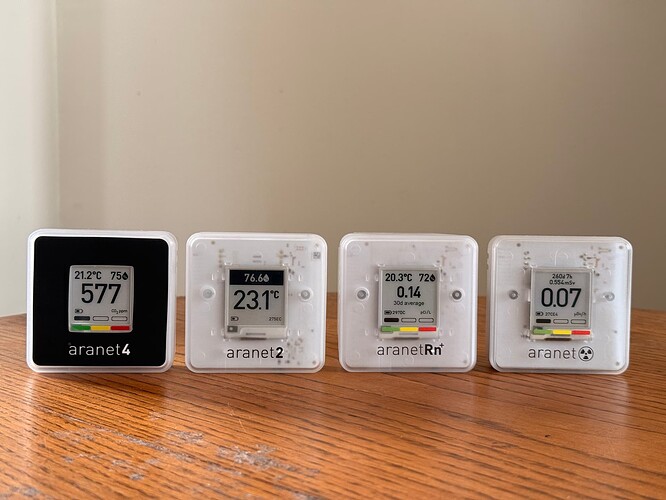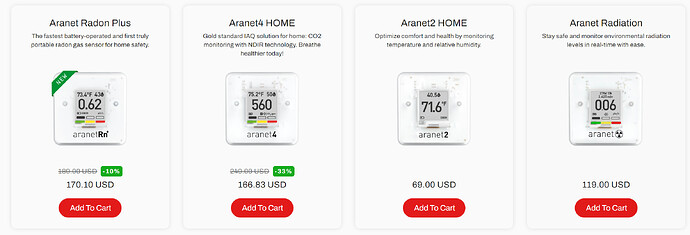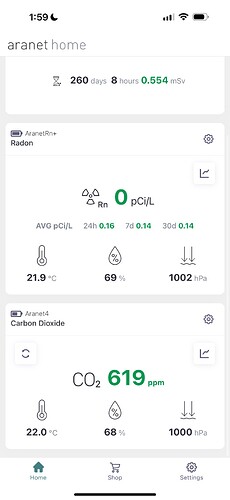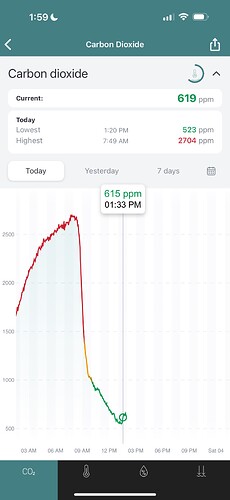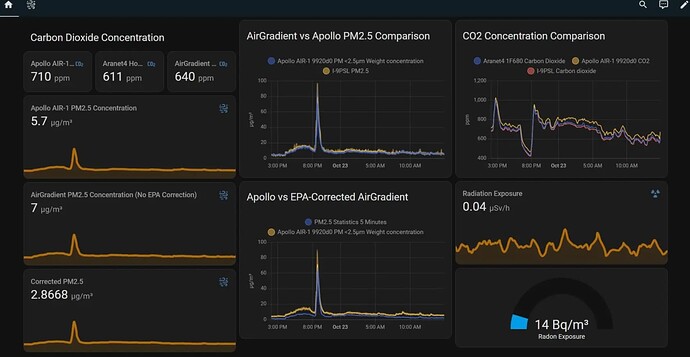On my main blog I always discuss monitors as they are, which generally means in isolation from other products in the same range. However, after recently writing a short post on Qingping air quality monitors as an ‘ecosystem’, I thought it would be interesting to do the same for the Aranet Home range of monitors.
If you would like to purchase any Aranet device, you can save 5% with the code BREATHESAFEARANET.
Before diving in, I do want to mention that if you’re interested in any monitors discussed in this post, you can purchase them from Aranet with a discount using the discount code ‘BREATHESAFEAIR’. This also supports me and allows me to keep investing time in writing posts like this!
So, what monitors currently exist in the Aranet Home lineup? Here’s a quick list:
- Aranet2 Home (temperature and relative humidity)
- Aranet4 Home (CO2, temperature, relative humidity & atmospheric pressure)
- Aranet Radiation (ionising radiation)
- Aranet Radon Plus (radon, temperature, relative humidity & atmospheric pressure).
While I’m sure this list will expand in the future (and I hope it does, as I still want a particulate matter sensor!), these are the current devices available in the lineup.
With this range, you can cover many important air quality metrics (and radiation), but you won’t yet get the full coverage that you would if you go for an ecosystem such as Airthings or Qingping (which, admittedly, lack radiation sensors and radon in the case of QP, but that include other metrics like PM). That said, you will also get some noticeable benefits, such as a full range of portable monitors, which neither Airthings nor Qingping currently offers.
Being from the same manufacturer, and since Aranet seems to be a stickler for consistency across devices, each of these devices shares some common features:
- Similar dimensions. All devices except for the Aranet Radon Plus share the exact same dimensions, and even the Radon Plus has the same width and height as the other monitors. It is, however, much longer.
- Fantastic battery life. All Aranet devices excel in battery life and are good portable options.
- High-quality components. Aranet places a lot of emphasis on high-quality components and well-thought-out products in regard to accuracy. A good example of this is how the Aranet4 Home features a built-in atmospheric pressure sensor to ensure CO2 readings are accurate at all elevations. Not many other manufacturers do this, and they’ve taken the same approach with their Radon Plus.
- Great app support. All Aranet Home devices use the Aranet Home app, which is, in my opinion, a fantastic app. I also like being able to consolidate all of my devices on one platform, so I really hope that Aranet releases a PM monitor in the future!
As you can see, some great features and advantages are consistent across the range of Aranet Home devices. However, there are some downsides, too. The biggest of these is that the Aranet range of monitors is pricey, and they sometimes come at a significant premium. The prices are high but acceptable for devices like the Aranet4 Home (with current pricing) and Aranet Radon Plus, as these devices are among the best in their class. However, at full price, the Aranet4 Home retails for $250, which is incredibly expensive for such a device. I also think that $70 for the Aranet2 is very pricey for a monitor that only measures temperature and relative humidity. I do believe the devices are very well-rounded, but the pricing is a big downside, and they feel almost like the Apple of air quality monitors.
There are many other advantages and disadvantages to the Aranet Home monitors, but these generally apply on an individual level, so I recommend reading my individual reviews for more information on these aspects:
Aranet2 Home:
Aranet4 Home:
Aranet Radiation:
Aranet Radon Plus:
Regardless of your devices, all those mentioned above will connect to the Aranet Home app. This is one of my favourite air quality apps as it offers a good balance of simplicity and advanced functionality. Even better, Aranet tends to be quite regular with updates, and I’ve seen both features get added (such as instantaneous measurements to the Aranet4 Home) and bugs get fixed through these updates.
Through the app, you can see the data from all of your monitors (even if you have multiple monitors of the same type), and there is also the option to export data if needed. This is a feature I always look for, as I appreciate delving deeper into my data and using more powerful tools like Excel or even ChatGPT (for analysis).
One downside regarding connectivity with the Aranet Home devices is that they all rely on Bluetooth and don’t offer WiFi. If you’re using the devices portably, this likely won’t cause an issue. However, if you’re trying to connect them to, for example, a smart home platform like Home Assistant, you will need to remember Bluetooth’s limitations. With that said, all Aranet Home devices support Home Assistant (with at least the core metrics), which is awesome news. In the image below, you can see all three panels on the right-hand side, either from or including an Aranet Home device.
Aranet Home devices also have limited support for other smart home platforms like Homey (currently, only for the Aranet4 Home, but I believe this may expand in the future).
Again, keep in mind the limitations of Bluetooth and the fact that, without additional receivers, the Aranet devices will have limited connectivity range to your smart home base. This limitation is a bit frustrating, making it seem like the Aranet devices are intended to be used individually (and portably) rather than as part of a smart home. However, Aranet does also have Pro variants of some monitors that are intended to fill this gap, but at a premium.
That about concludes it for now. As new devices are released, or as I think of more things to add to this post, I will return to it and update it. However, suppose you’re looking for a good ‘ecosystem’ of air quality monitoring devices to invest in. In that case, Aranet is worth considering as long as you don’t mind the lack of a PM monitor. They’re pricey, but they’re also very good devices.
Oh, and make sure to prepare a lot of AA batteries, as each Aranet device will require two!
